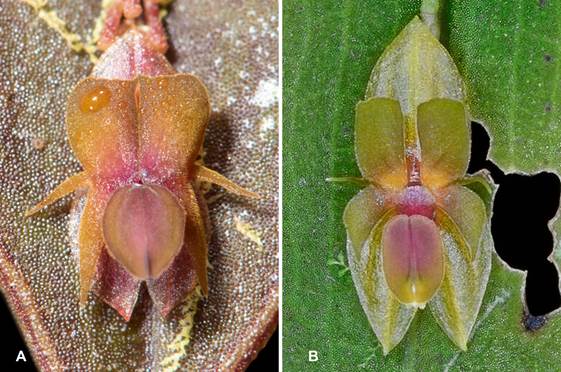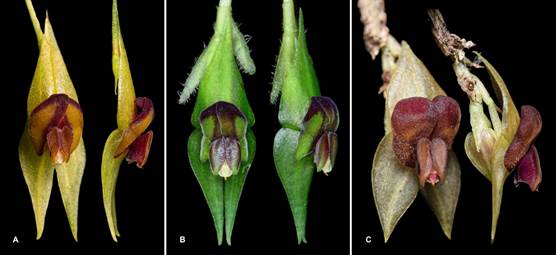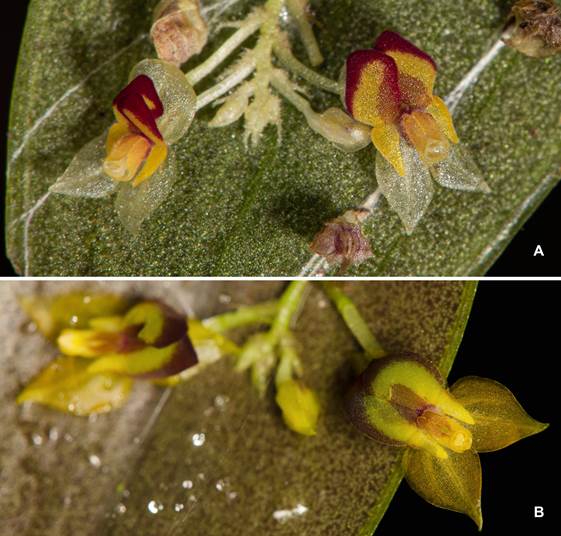Introduction
Lepanthes Sw., one of the most diverse genera in species number within the Orchidaceae (Karremans & Vieira-Uribe 2020), comprises more than 300 species described in Colombia, and new species are discovered and described every year (Baquero et al. 2021, Luer & Thoerle 2012, Restrepo et al. 2022). In the last seven years in San José del Salado, located on the western slope of the Western Andes of Colombia, Department of Valle del Cauca in the Municipality of Dagua, eleven new species from the genera Pleurothallis R.Br., Epidendrum L. and Lepanthes (Moreno et al. 2021) have been described. Furthermore, in 2022, several expeditions to the mountains of San José del Salado were made, and during these field trips, four new species of Lepanthes were discovered. Here, we describe, illustrate, and provide information about their distribution and similarity with the most closely related species.
Material and methods
Descriptions and drawings.- The descriptions and drawings were prepared from living specimens and flowers preserved in 70% alcohol. Flowers were dissected, measured, and photographed using Celestron Handheld Digital Microscope Pro. Vegetative structures were measured from dried material and reproductive structures from spirit material. Digital images were taken with a Nikon d750 or Nikon D810 and a 105mm f/2.8 macro lens. Sketches from living and preserved specimens were digitized, and the images were used for diagramming a draft composite template in Adobe Photoshop® CS6. A digital composite line drawing was then made (lines and stippling) in Procreate illustration application for iPad 6th generation tablet computer (Bogarín et al. 2019). The new species were described following the botanical terminology by Stearn (1992), Beentje (2012), and Luer & Thoerle (2012). In addition, all original descriptions of related species were consulted for detailed comparisons (Dodson & Luer 2011, Luer 1996, Luer & Thoerle 2012).
Plant material.- Specimens from the following herbaria: AMES, CAUP, COL, CUVC, HUA, JAUM, JBB, VALLE, and MO (online) were consulted, and no additional material of the new species was found.
Taxonomic treatment
Lepanthes cardenasii J.S.Moreno, Gal.-Tar. & Zuluaga, sp. nov. (Fig.1,2,3A)
TYPE: Colombia. Valle del Cauca: Municipio de Dagua, Corregimiento de San José del Salado, 1716 m, 11 Jul 2020, R. Galindo-T, D.L. Mora, J. Serna & C. Silva 1485 (Holotype: CUVC-Spirit).
Diagnosis: Lepanthes cardenasii is most similar to L. praemorsa Luer & R.Escobar but is differentiated by a lip with the blades wide and lunate (vs. the blades thin and oblong), with a reduced ovate and bifid appendix (vs. appendix thick and broadly triangular).
Plant small to medium in size, epiphytic, caespitose, 6.4-10.2 cm tall; roots slender, filiform 0.5-0.6 mm in diameter. Ramicauls sub-erect, weak, slender, horizontal, 3.8-7.5 cm long, enclosed by 6-10 closely fitting, microscopically ciliate-scabrous long acuminate lepanthiform sheaths with narrowly dilated, acuminate ostia. Leaves with brown edges, elliptic, thinly coriaceous, long acuminate, the apex emarginate with an abaxial apiculum in the middle, 1-8 × 0.5-2.0 cm, the base obtuse, contracted into a petiole 4.3-7.0 mm long. Inflorescence a congested, distichous, successively many-flowered, 7-11, raceme up to 1.6 cm long, including the peduncle, held appressed to the adaxial surface of the leaf by a filiform, terete peduncle, 3.4-7.8 cm long, borne near the apex of the ramicaul; floral bracts conical, acuminate 0.7-1.0 mm long; pedicels terete, 1.4-1.7 mm long. Ovary terete, costate, curved up, 1.9 mm long. Flowers with sepals pale green-brown; petals brownish yellow; lip burgundy in the center brownish-yellow in the borders, ovary red. Dorsal sepal suborbicular, convex, acute, 3-veined, 2.35 × 2.49 mm, connate to the lateral sepals for 0.6 mm. Lateral sepals ovate, oblique, acute, 2-veined, 1.9 × 1.4 mm, connate for 1.2 mm. Petals microscopically pubescent, transversely bilobed, 3.6 × 1.3 mm, with a filiform lateral midlobe, 1 mm long; the upper lobe subquadrate, sharply truncate, with a pronounced and acuminate inner corner, the upper edge praemorse; the lower lobe sub-triangular, oblique, acute. Lip minutely pubescent, bilaminate, the blades wide, membranaceous, thin, adherent medially over the column, sub-lunate with rounded ends, minutely ciliate, 2.8 × 1.4 mm, supported by short, thin cuneate connectives, from the base, the body wide, concave, adnate to the base of the column, the sinus obtuse, with a reduced, ovate, bifid, ciliate appendix. Column urceolate, flattened, 1.5-2.5 mm long, the anther dorsal and stigma ventral, the stigmatic cavity wide and expanded towards the base, bilobulate. Anther cap cordate, cucullate, 0.4 mm wide. Pollinia yellow, two, pyriform, 0.5 mm long.
Eponymy: The name of the new species honors Dairon Cárdenas López (1957-2022), one of the most prolific Colombian botanists and plant collectors who worked at Instituto Amazónico de Investigaciones Científicas- SINCHI. Dairon collected more than 50,000 plant specimens, mainly in the most remote places of the Colombian Amazon. Many of his collections represent new species and new records of plants for the country.
Habitat and Ecology: Lepanthes cardenasii was found growing on Andesanthus lepidotus (Bonpl.) P.J.F.Guim. & Michelang. (Melastomataceae) isolated trees in cattle fields, close to a very well-preserved forest.
Lepanthes cardenasii is related to a group of species morphologically similar to L. mucronata Lindl., with a weak habit, ovate and acuminate leaves, small flowers born on top of the leaf, proportionally large petals compared with the size of the sepals, and a lip with thin, well-developed blades and sometimes concave appendices (Luer & Thoerle 2012). The most similar species is L. praemorsa (Fig. 3B), an endemic species from Colombia, but the new species could be easily distinguished by its suborbicular and small sepals (vs. ovate and larger), the petals praemorse but with a pronounced and acuminate inner corner and almost as wide as the length of the sepals (vs. praemorse petals with an absent inner corner, as wide as the length of the dorsal sepal); the lip bilaminate, with the blades wide and lunate (vs. the blades thin and oblong), with a reduced ovate and bifid appendix (vs. appendix thick and broadly triangular).
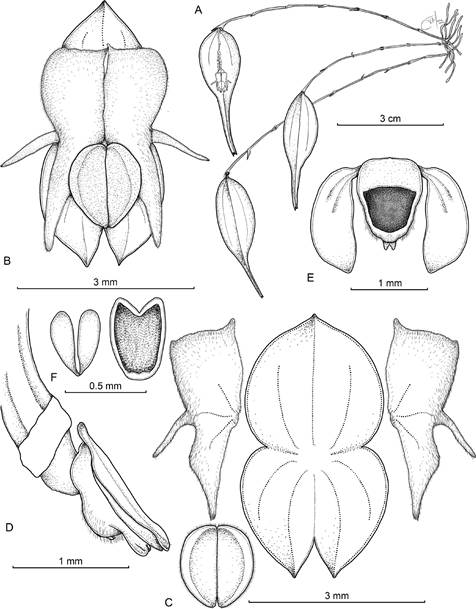
A. Habit.
B. Flower.
C. Dissected perianth.
D. Ovary, column and lip, side view.
E. Expanded lip.
F. Pollinia and anther cap.
Drawn by J.S. Moreno from the plant that served as the holotype.
Figure 1 Drawing of Lepanthes cardenasii J.S.Moreno, Gal.-Tar. & Zuluaga.
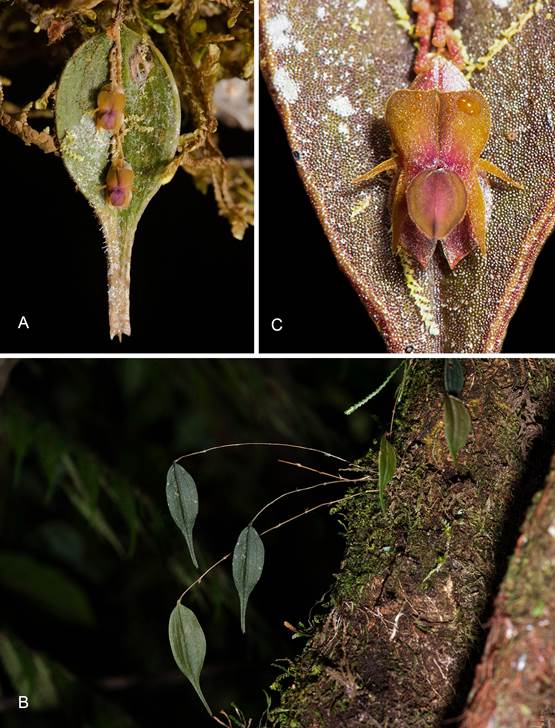
A. Leave and flower.
B. Front view of the flower.
C. Habit and plant in-situ.
Photographs by R.G. Tarazona.
Figure 2 Photographs of Lepanthes cardenasii J.S.Moreno, Gal.-Tar. & Zuluaga.
Lepanthes davidii Gal.-Tar., Zuluaga & J.S.Moreno, sp. nov. (Fig.4,5,6C)
TYPE: Colombia. Valle del Cauca: Municipio de Dagua, corregimiento El Limonar, Quebrada La Española, 1700 m, 24 Jan 2021, A. Zuluaga, R. Galindo-T & D.L. Mora 5077 (Holotype: CUVC-Spirit).
Diagnosis: Lepanthes davidii is most similar to L. ankistra Luer & Dressler, but can be easily distinguished by the petals with the lower lobe triangular, acute (vs. petals with the lower lobe subfalcate and strongly uncinate), the lip with blades oblong-lunate with the apex and base sub-acute, (vs. blades ovate with the apex rounded and an acute base), and a bisegmented slender appendix with an ovoid deflexed apical portion (vs. single segment concave appendix with an apical gland).
Plants medium in size, epiphytic, caespitose, 13.1-17.4 cm tall; roots, slender, flexuous, filiform, 0.4 mm in diameter. Ramicauls slender, suberect to horizontal 10.8-15.3 cm long, enclosed by 6-13 acuminate, furrowed, and microscopically pubescent lepanthiform sheaths, with a dilated, ciliate ostia. Leaves purple, more or less vertical at an angle of 90º from the ramicaul, coriaceous, corrugate, reticulate-veined, with 8 main veins, corrugate, ovate, attenuate, 6.1-6.9 × 2.3-3.4 cm, the apex emarginate with an abaxial apiculum in the middle, the obtuse base cuneate contracted into a petiole 2-3 mm long. Inflorescence a congested, distichous raceme, 12-26, successively many-flowered, up to 1.3-4.4 cm long, including the peduncle, held appressed to the adaxial surface of the leaf by a filiform, terete peduncle, 0.7-3.1 cm long, borne near the apex of the ramicaul; floral bracts conical, acuminate, minutely ciliate, 0.5-1.1 mm long; pedicels terete, 2.2-2.6 mm. Ovary terete, costate, 2.5 mm long. Flowers with sepals fulvous-yellow, dorsal sepal reddish-brown in the center; petals with lobes dull green, reddish-brown in the center; lip dull red-violet, column dull green. Dorsal sepal broadly ovate, acute, slightly revolute in natural position, 3-veined, 3.3-4.0 × 2.7-2.9 mm connate to the lateral sepals for 0.9 mm. Lateral sepals, ovate, oblique, slightly attenuate, 2-veined, 2.9-3.4 × 1.9-2.0 mm, connate for 1.6-1.7 mm long. Petals transversally bilobed, pubescent, imbricate 0.9-1.3 × 4.3-6.5 mm, with a filiform marginal midlobe, 1.1-1.7 mm long, 3-veined; the upper lobe oblong, sub-falcate, truncate, minutely erose; the lower lobe triangular, sub-sigmoid towards the apex, acute. Lip bilaminate, microscopically pubescent, the blades oblong-lunate, with sub-acute base and apices, thin, flat, adherent medially to each other over the column, 2.2-3.1 × 0.6-0.8 mm, supported by cuneate connectives from near the middle, the body broad, adnate to the base of the column, the sinus obtuse, with a bisegmented slender, recurved, pubescent appendix with an ovoid apical portion deflexed and the basal portion concave. Column, terete, bilobed with short, lateral, triangular lobes, 1.5 mm long, the clinandrium large, rostellum oblong-truncate, the anther dorsal, and stigma ventral. Anther cap cordate, cucullate, 0.5 mm wide. Pollinia 2, yellow, pyriform, narrowly obovoid, 0.7 mm long.
Eponymy: The name honors Andres David Galindo Rey, son of Robinson Galindo-Tarazona, the first author of the species.
Habitat and Ecology: Lepanthes davidii has been found up to 1.5 m high in a humid secondary forest and shares a habitat with L. irmae Gal.-Tar., Zuluaga, J.S.Moreno & Mora-Aguilar. It has been observed in a second locality sharing habitat with L. satyrica Luer & Hirtz, L. yubarta E.Calderón, and L. dumbo Luer.
Lepanthes davidii is most similar to L. ankistra from Costa Rica, Panama, and Colombia, a species also with reticulate leaves but distinguished easily by its transversely bilobed petals with the lower lobe strongly uncinate (Fig. 6A) (vs. the lower lobe triangular, falcate towards the apex and acute). The most relevant feature that defines the identity of L. davidii is the appendix, which is bisegmented, slender, recurved, pubescent with an ovoid apical portion deflexed, and the basal portion concave (vs. a concave and ciliate appendix but with an apical gland (Luer & Dressler 1986). Another similar species from Colombia is L. brunnescens Luer, recognized and separate from this species by having no uncinate lower lobes in its transversely bilobed petals (Fig. 6B) but with the same blades of the lip and appendix as L. ankistra. From the western Andes of Colombia, L. sinuosa Luer & R.Escobar (Fig. 6D) is also recognized by its thin ovate leaves, acute, slightly acuminate, and reticulate with markedly sinuate margin (vs. margin entire), truncate lower lobe of the transversely bilobed petals (vs. the lower lobe triangular, sub-sigmoid towards the apex, acute), the blades of the lip flat, falcate, adherent below the middle over the column (vs. the blades oblong-lunate, with sub-acute base and apices, thin, flat, adherent medially to each other over the column) and the appendix is boat-shaped and pubescent, with a bifid gland at the apex (vs. bisegmented slender, recurved, with an ovoid apical portion deflexed and the basal portion concave).
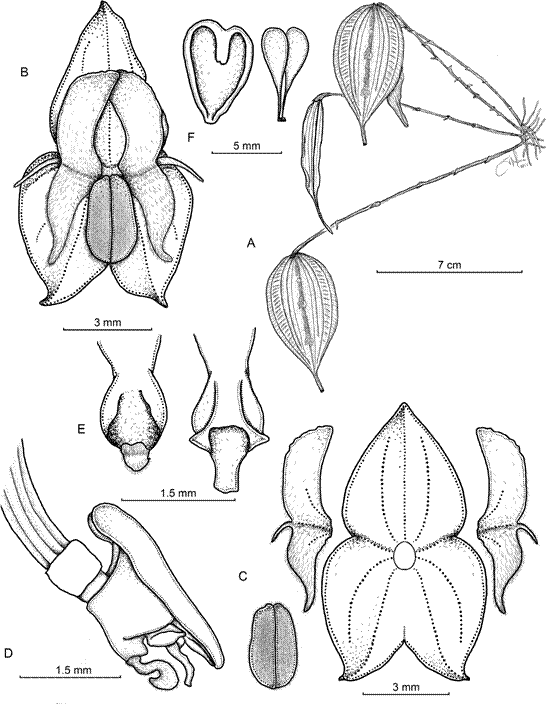
A. Habit.
B. Flower.
C. Dissected perianth.
D. Ovary, column and lip, side view.
E. Dorsal view of the appendix without the column (left) and dorsal view of the column showing the short wings.
F. Anther cap and pollinia.
Drawn by J.S. Moreno from the plant that served as the holotype.
Figure 4 Drawing of Lepanthes davidii Gal.-Tar., Zuluaga & J.S.Moreno.
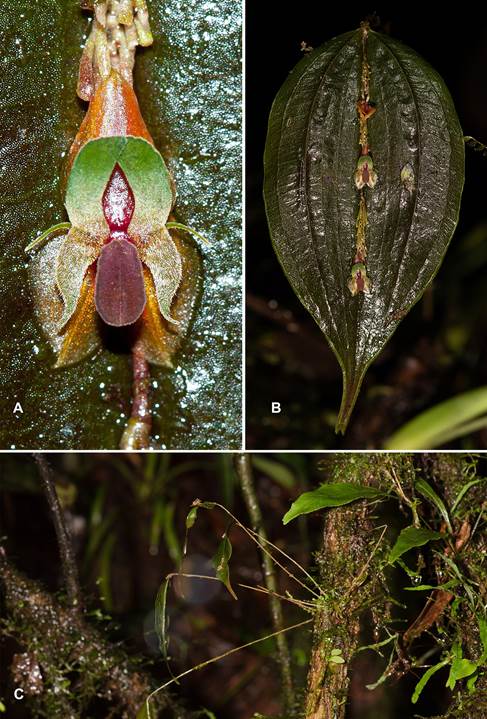
A. Front view of the flower.
B. Leave with inflorescence.
C. Habit and plant in-situ.
Photographs by R.G. Tarazona.
Figure 5 Photographs of Lepanthes davidii Gal.-Tar., Zuluaga & J.S.Moreno.
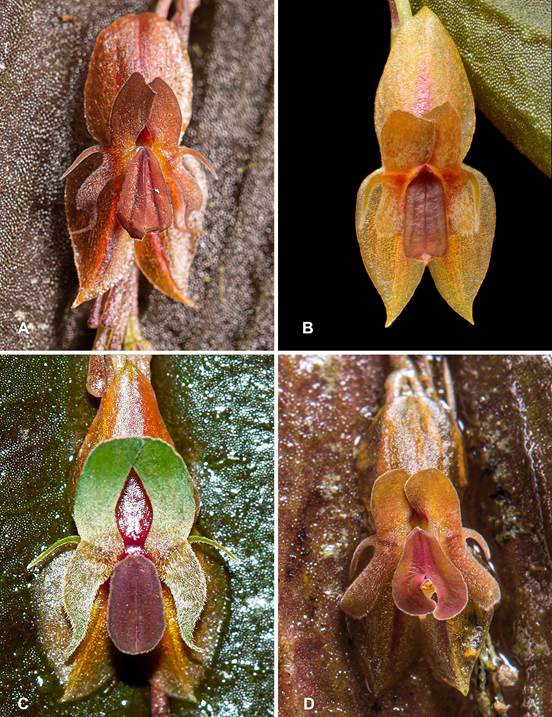
A. Lepanthes ankistra Luer & Dressler.
B. Lepanthes brunnescens Luer.
C. Lepanthes davidii.
D. Lepanthes sinuosa Luer & R.Escobar.
Photographs by J.S. Moreno (A, D), Peter Peeters (B), and R.G. Tarazona (C).
Figure 6 Comparison of Lepanthes davidii Gal.-Tar., Zuluaga & J.S.Moreno with the most similar species.
Lepanthes dorae J.S.Moreno, Gal.-Tar. & Zuluaga, sp. nov. (Fig.7,8,9A)
TYPE: Colombia. Valle del Cauca: Municipio de Dagua, corregimiento El Limonar, quebrada La Española, 1700 m, 24 Jan 2021, A. Zuluaga, R. Galindo-T, D. L. Mora & J.S.Moreno 5078 (Holotype: CUVC-Spirit).
Diagnosis: Lepanthes dorae is similar to L. pachyglossa Luer, but the new species can be distinguished by ovatelanceolate sepals (vs. triangular-ovate); the transversely bilobed petals with the lower lobe triangular and falcate (vs. the lower lobe broadly uncinate), and the most distinguishing characteristic is the oblong, bilobed pubescent appendix, located into an anterior cavity from the sinus (vs. an external, short, minute appendix).
Plants medium in size, epiphytic, caespitose, 11.3-15.5 cm tall; roots, slender, flexuous, filiform, up to 0.65 mm in diameter. Ramicauls slender, erect, 8.7-12.0 cm long, enclosed by 8-15 acuminate, furrowed, and longciliate lepanthiform sheaths, with a dilated, ciliate ostia. Leaves erect, coriaceous, elliptical, attenuate, the blade subplicated above the base, with three main veins, 5.90-8.47 × 1.73-2.19 cm, the apex emarginate with an abaxial apiculum in the middle, the obtuse base cuneate contracted into a petiole of 2-3 mm long. Inflorescence a congested, distichous raceme, 13-15, successively many-flowered, 2.73-3.75 cm long, including the peduncle, held appressed to the abaxial surface of the leaf by a filiform, terete peduncle, 1.65-2.68 cm long, borne near the apex of the ramicaul; floral bracts conical, acuminate, minutely verrucose, 1.45-1.66 mm long; pedicels terete, 1.44-1.87 mm. Ovary terete, costate, 2.03-3.10 mm long. Flowers with sepals pale green-yellow; petals dark red in the borders, yellow in the middle; lip redbrown. Dorsal sepal ovate-lanceolate, slightly convex, acute, 3-veined, 5.85-8.26 × 2.99-4.62 mm connate to the lateral sepals for 0.9 mm. Lateral sepals, ovate-triangular, oblique, acute, sometimes imbricate in natural position, 2-veined, 5.17-7.61 × 1.86-2.87 mm, connate for 1.2-1.85 mm long. Petals transversally bilobed, microscopically pubescent, imbricate, 3-veined, 1.45-2.05 × 3.09-4.63 mm; the upper lobe broadly-oblong, rounded; the lower lobe triangular, falcate towards the apex, rounded. Lip bilaminate, the blades with the base obtuse and the apices acute, hirsute, embracing the column, clavate, 3.5-2.25 × 0.33-0.61 mm, supported by broadly cuneate connectives, the body broad, thick, adnate to the base of the column, the sinus thick, protuberant with a cleft cavity on the anterior surface into which the oblong, pubescent and bilobed appendix fits. Column terete, 1.24-1.99 mm long, the rostellum protruding, the anther dorsal, and stigma ventral. Anther cap cordate, cucullate, 0.63-0.67 mm wide. Pollinia 2, yellow, pyriform, narrowly obovoid, 0.44-1.07 mm long.
Paratype: Colombia. Valle del Cauca: Municipio de Dagua, corregimiento El Queremal, vereda El Descanso km 55, Avistamiento de Aves Doña Dora, 1400 m, 6 Dec 2016, J.S.Moreno & A.L.Erazo 337 (CAUP).
Eponymy: The name of the new species honors Dora Alicia Londoño Hoyos ''Doña Dora'', a woman who has developed a spot for bird watching in the km 55, El Descanso, El Queremal, Valle del Cauca Department, one of the locations where the new species was found.
Habitat and Ecology: Lepanthes dorae has been found growing in two localities in Valle del Cauca. In the first locality in San José del Salado, it was found in a very humid area in a secondary forest, growing close to the ground near a small creek that flows into the Quebrada Española, sharing the habitat with L. aciculifolia Luer, L. pogonochila Zuluaga, Alegria-Valencia, J.S.Moreno & Gal.-Tar., L. escifera Luer & R.Escobar, L. agglutinata Luer, and L. posadae Luer & R.Escobar. In El Queremal, the new species was found growing in dead branches covered by moss next to L. filamentosa Luer & Hirtz.
Lepanthes dorae is most similar to Lepanthes pachyglossa from Panama (Luer 1985), which is characterized by having the petals transversely bilobed with the upper lobe oblong-rounded and the lower lobe smaller, broadly-uncinate (vs. the upper lobe broadly-oblong; the lower lobe triangular, falcate towards the apex, rounded), and the lip with the appendix with a minute, external appendix (vs. a large bilobed appendix located into a cleft cavity on the anterior surface). From Colombia two species are very similar. Lepanthes porracea Luer & R.Escobar (Fig. 9B) is distinguished by its petals which are transversely broadly oblong with rounded apices (vs. the upper lobe broadly-oblong; the lower lobe triangular, falcate towards the apex), the blades of the lip flat, elliptical with the ends rounded (vs. the blades with the base obtuse and the apices acute) and with a small and densely pubescent appendix (vs. large bilobed appendix located into a cleft cavity on the anterior surface). Lepanthes troglodytes Luer & R.Escobar (Fig. 9C) is recognized by its larger leaves, the lip with the blades flat, acute (vs. clavate, the base obtuse and the apices acute), and a hinged oblong pubescent appendix (vs. an oblong bilobed pubescent appendix).
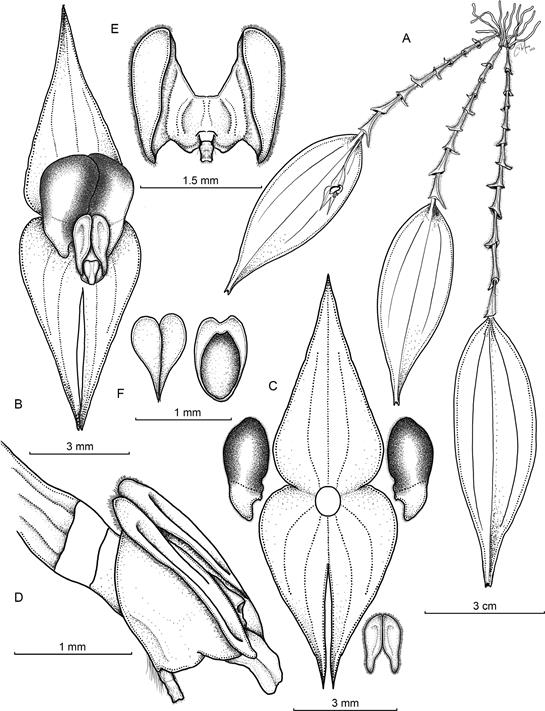
A. Habit.
B. Flower.
C. Dissected perianth.
D. Ovary, column and lip, side view.
E. Expanded lip.
F. Pollinia and anther cap.
Drawn by J.S. Moreno from the plant that served as the holotype.
Figure 7 Drawing of Lepanthes dorae J.S.Moreno, Gal.-Tar. & Zuluaga.
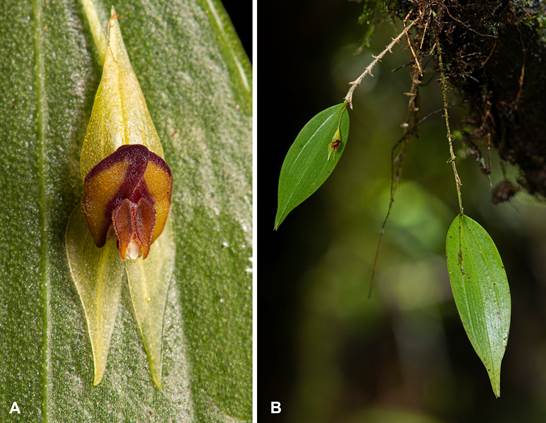
A. Front view of the flower.
B. Habit and plant in-situ.
Photographs by J.S. Moreno.
Figure 8 Photographs of Lepanthes dorae J.S.Moreno, Gal.-Tar. & Zuluaga.
Lepanthes morae Zuluaga, J.S.Moreno, Gal.-Tar., sp. nov. (Fig.10,11,12A).
TYPE: Colombia. Valle del Cauca: Municipio de Dagua, corregimiento El Limonar, Quebrada La Española, 1700 m, 10 Jan 2022, R. Galindo-T, D. L. Mora & A. Zuluaga 1558 (Holotype: CUVC-Spirit).
Diagnosis: Lepanthes morae is most similar to Lepanthes declivis Luer & R.Escobar, but the new species could be easily distinguished by its thick, fimbriate, and concave bilaminate lip with the blades narrowly-oblong, shortly depressed laterally, externally with a thick callus at the base of the connectives. Each blade with spathulate, rounded apices overlapped beneath the apex of the column, with no appendix (vs. bilaminate lip, with the blades elliptical, microscopically ciliate, the appendix small, oblong and ciliate).
Plant medium in size, epiphytic, caespitose, 8.4-13.3 cm tall; roots, slender, flexuous, filiform, up to 0.46 mm in diameter. Ramicauls erect 4.3-7.4 cm long, enclosed by 6-14 acuminate, furrowed lepanthiform sheaths, with a dilated, oblique ostia. Leaves erect, coriaceous, elliptical-lanceolate, attenuate, 3.84-5.79 × 0.90-1.14 cm, the apex emarginate with an abaxial apiculum in the middle, the obtuse base cuneate contracted into a petiole of 1.54-2.26 mm long. Inflorescence a dense, congested, distichous, long-pedicellate raceme, successively many-flowered, 30-56, 2/3 the length of the leaf, 1.7-3.4 cm long including the peduncle, held appressed to the abaxial surface of the leaf by a filiform, terete peduncle, 1.0-2.1 cm long, borne near the apex of the ramicaul; floral bracts conical, acuminate, muricate, 0.81-1.25 mm long; pedicels terete, 1.52-1.88 mm. Ovary conical, costate, curved up 2.03-3.10 mm long. Flowers with sepals translucent green-yellow; bright yellow, with the center orange-yellow and border or the upper lobe red,; lip yellow-orange; column purple. Dorsal sepal broadly-ovate, convex, acute, 3-veined, 1.63-2.47 × 1.40-2.25 mm connate to the lateral sepals for 0.34 mm. Lateral sepals, ovate, oblique, acute, 2-veined, 1.59-2.23 × 0.85-1.30 mm, connate for 0.80 mm long. Petals transversally bilobed, microscopically pubescent, imbricate, 1.08-1.12 × 2.78-2.88 mm; the upper lobe broadly-elliptic, rounded, twice as wide as the lower lobe; the lower lobe triangular, obtuse, oblique. Lip bilaminate, thick, concave, the blades narrowly-oblong with the bases rounded, fimbriate, embracing the column, the apices spathulate and rounded, overlapped beneath the apex of the column in natural position, 1.11 × 0.36 mm, supported by broadly cuneate connectives, shortly depressed laterally in the outer side, externally with a thick callus at the base of the connectives, the body broad, very thick, adnate to the base of the column with no appendix. Column terete, with an expanded apex, 1.30-1.48 mm long, the anther dorsal, and stigma ventral. Anther cap not seen. Pollinia not seen.
Eponymy: The name of the new species honors Danny Leandro Mora, who has been exploring the flora and fauna of the forests around his hometown San José del Salado, for several years, leading us to discover several new species.
Habitat and Ecology: Lepanthes morae shares habitat with L. davidii, as they grow at the same locality. Lepanthes morae vegetatively is similar to other species from Colombia with very congested racemes that are born on the abaxial surface of an elliptical and acuminate leaf, such as L. cogolloi Luer & R.Escobar, L. declivis, L. perdita Luer & Hirtz, and L. setifera Luer & R.Escobar. However, the most similar species is probably L. declivis (Fig. 12B), a species that can be identified by its ovate and slightly convex leaves (vs. ellipticallanceolate), and long pedicels and ovaries, 2.0-2.5 and 4 mm long, respectively (vs. pedicel 1.52-1.88 mm and ovary 2.03-3.10 mm long). Finally, the most distinctive feature of L. morae is the lip with the bases of the elliptical blades, abruptly reflexed with the apices narrowed and recurved beneath the column and the connectives narrow with an oblong and ciliate appendix (vs. blades of the lip narrowly-oblong with the apices spathulate and rounded, overlapping beneath the apex of the column, thick and concave; the broad connectives cuneate, shortly depressed laterally with a thick callus at the base of each connective in the outer side with no appendix).
The most striking features that separates Lepanthes morae from other similar species is the presence of a small callus at the base of the outer face of the connectives, and the spathulate and rounded apices of the lip blades that overlap beneath the apex of the column, and the absence of an appendix.
Conservation status: Lepanthes cardenasii, L. davidii, L. dorae, and L. morae are known only from one or two localities in the same mountain range. Therefore, the IUCN classification is data deficient (DD) because adequate population and distribution information to make an assessment is not available.
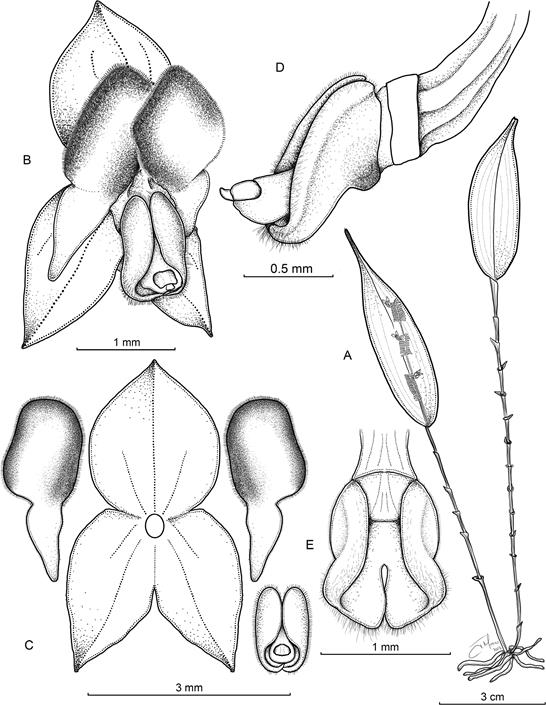
A. Habit.
B. Flower.
C. Dissected perianth.
D. Ovary, column and lip, side view.
E. Expanded lip.
Drawn by J.S. Moreno from the plant that served as the holotype.
Figure 10 Drawing of Lepanthes morae Zuluaga, J.S.Moreno & Gal.-Tar.
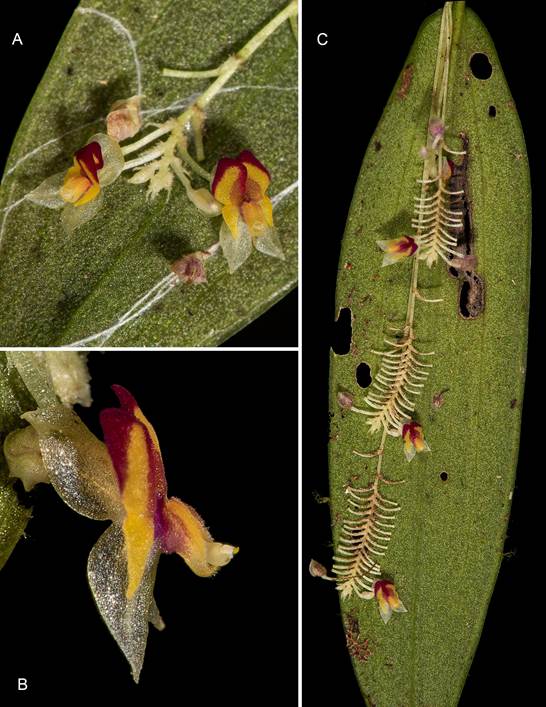
A. Flowers with the inflorescence.
B. Side view of the flower.
C. Habit and plant showing three congested racemes of the inflorescence.
Photographs by R.G. Tarazona.
Figure 11 Photographs of Lepanthes morae Zuluaga, J.S.Moreno & Gal.-Tar.












 uBio
uBio 

